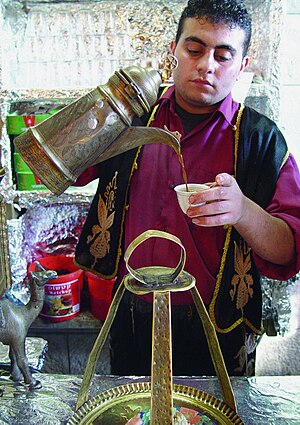Translations:Coffee in world cultures/11/en
Coffeehouse culture

Coffeehouse culture began in the Arab world, and eventually spread to other areas of the world and blended with the local culture. Traditional Arab coffeehouses are places where mostly men meet to socialize over games, coffee, and water pipes (shiisha or agriile). Depending on where the coffeehouse is, its specialty differs. In North Africa, green tea is served with mint, and coffee is served European style. Arabic coffee, or Turkish coffee, is made in Egypt and the Levant countries. Arabic coffee is a very small amount of dark coffee boiled in a pot and presented in a demitasse cup. Particularly in Egypt, coffee is served maZbuuT, which means the amount of sugar will be "just right", about one teaspoon per cup. However, in the Arabian Peninsula, Arabic coffee is roasted in such a way that the coffee is almost clear; it is traditional for the host to refill the guest's cup until politely signaled that the guest is finished.

Coffeehouses have gained popularity in other countries such as Turkey and Iran. Turkey, for example, shares many similarities to Arabic coffeehouses as they integrated into the culture during the Ottoman Empire's reign. On the other hand, Austria's popular Viennese coffeehouses were created with Europe's introduction to coffee. These coffeehouses are dissimilar in that they are not usually places of gathering, instead many people go to sit alone and enjoy coffee. Other variations have been created as the world has modernized: coffeeshops in North America and the Philippines, kopi tiam in Malaysia and Singapore, and cafes in various other countries.